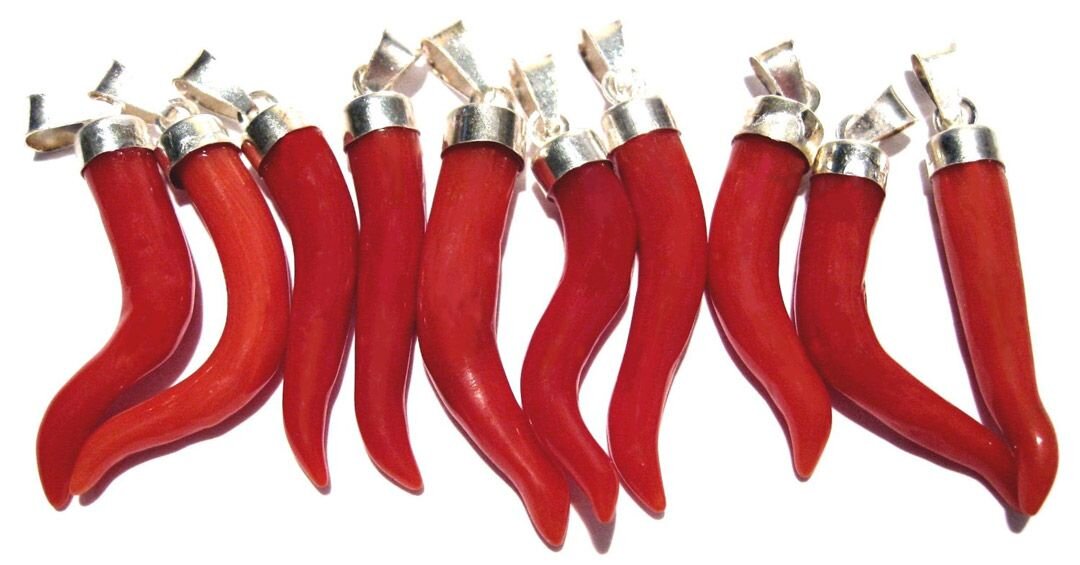Cornicello: The Little Horn of Protection and Power
Long before it dangled from gold chains around the necks of Italian grandfathers and Fiat rearview mirrors, the cornicello — Italy’s famous “little horn” — was a powerful relic of ancient magic. Its shape is unmistakable: a single, twisted horn, usually curved and tapering to a point. It may look simple, but this humble object carries centuries of belief, blending Pagan fertility rites, Roman animal symbolism, and southern Italian superstition into one compact charm.
***
The cornicello — also known as the cornetto, corno, or cornuto — is one of the most recognizable amulets in Italian folk tradition. Modeled on the shape of an animal horn, it symbolizes virility, vitality, and masculine strength. At its core, it is a phallic symbol. Often worn as jewelry or hung in homes, the cornicello serves as a protective charm, warding off misfortune and shielding its bearer from the age-old threat of the malocchio — the evil eye.
Traditionally, cornicelli are carved from red coral, a material believed to carry potent magical properties, particularly for fertility and protection. Over time, the horn has also been rendered in gold, silver, bronze, clay, glass, and even plastic — with each version said to carry its own weight of symbolism. A cornicello topped with a gold crown is thought to amplify its powers, adding a wish for wealth and status to its protective function. Some scholars even link the cornicello to the cornucopia, the “horn of plenty,” another curved horn that spills forth abundance.
The Cornicello’s Cousins
Though the cornicello is a single curved horn, it is often paired with another symbol of protection: the mano cornuto, or “horned hand,” a gesture made by extending the index and little finger while curling the rest. Both the cornicello and mano cornuto serve as amulets against envy, bad luck, and hidden malice. In some regions, they are worn together as a composite charm for added potency. Another hybrid charm is the corno gobbo — a whimsical amulet made with the top half of a hunchback and the bottom half of a horn — playing on the idea that a hunchback, too, is both lucky and protective. (For more explanation of that idea, take a read through this post.)
The corno’s power isn’t limited to decorative replicas. In some areas of southern Italy and Sicily, actual horns from goats or bulls are used as protective talismans. These might be painted red and mounted above a home’s front door so that visitors must pass beneath them, unknowingly shedding any evil intentions or curses before crossing the threshold. Even crab claws have been repurposed in similar ways, their natural curvature echoing the classic horn form.
If you are in the market for an authentic cornicello, Napoli is the place to be. The House recommends Cosmos specifically, on San Gregorio Armeno, a street that is (mostly) filled with handcrafted goods from local artisans. The cornicelli from Cosmos are beautifully packaged and come with the following instructions:
The Lucky Horn (How To Use It)
The lucky horn must be given and activated with a ritual; whoever gives it has to sting with the tip of the horn the left hand palm of the receiver; this first contact between the amulet and the person allows the horn to recognize its owner and start protection.
Those who receive it can use it in two ways: 1) as a personal amulet; always carry the horn with them and caress it when they feel negativity; 2) as an amulet for the house; rub the tip of the horn on the threshold of the entrance door three times from the inside to the outside; in this way the horn will recognize the environment to be protected. Hang the horn at the entrance. The same ritual applies to offices, cars, shops, etc…
This way the horn absorbs the negativity addressed to who owns it and when it is saturated it will break. Once broken it will have exhausted the power; it must be washed and thrown away or buried in a plant.
The horn is the most famous symbol of Neapolitan superstition. On lots of doors and balconies you can find bunches of red peppers instead, because their hot seeds, symbolically, ward off evil tongues. We no longer remember what the horn really means. We touch it without knowing why. Yet the horn is only the stylization of a phallus, belonging to the Greco-Roman god Priapus, guardian of the lands, protector from the evil eye and god of fecundity/prosperity, the house and fishing.
The horn are actually designed to ward off the evil eye and bring good luck. As the famous Neapolitan philosopher Benedetto Croce once said: “I don’t believe in superstitions, but I take them into account.” GOOD LUCK!!!
Mistaken Identity, Shared Symbolism
Because of its bright red color and tapered shape, the cornicello is sometimes mistaken for a chili pepper — and the confusion isn’t entirely misplaced. The resemblance has inspired certain chili varieties to adopt names like Corno di Toro (“bull’s horn”), reinforcing the connection between heat, strength, and horn-shaped luck.
And remarkably, chili peppers carry their own superstitions of fortune. In the American Southwest, dried pepper garlands — ristras — hang from homes as traditional symbols of health and abundance. The belief is that these fiery strands don’t just ward off illness but actively invite good luck. Similarly, in Chinese feng shui, red chili pepper tassels are hung in homes and businesses to attract prosperity and success. In this way, the symbolic lineage of the cornicello extends far beyond Italy, linking a shared, cross-cultural language of protection and plenty.
One Charm, Many Lives
Whether carved from coral or shaped from silver, whether worn on the chest or hung above the door, the cornicello endures because it does what all the best talismans do: it says something without speaking. It reminds us that luck isn’t just found — it’s invited, protected, and sometimes even conjured.
Further Reading:
On the other meaning of cornuto… Cornuto Contento

Horseshoe and Cornicelli at a street fair

Ristra



Corno Gobbo holding a lucky horseshoe on a bed of chili peppers
Corno di Toro Pepper


Coral cornicello

Beaded Chili Pepper, House of Good Fortune Collection

Chili Pepper Tassel, House of Good Fortune Collection

Brass corno, House of Good Fortune Collection

Twisted Cornicello and Mano Cornuta, House of Good Fortune Collection

Mano cornuto in situ on Park Avenue, New York, NY

Cornicello dangling from horseshoe; acquired from E. Rossi & Co.; House of Good Fortune Collection


